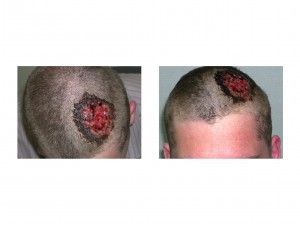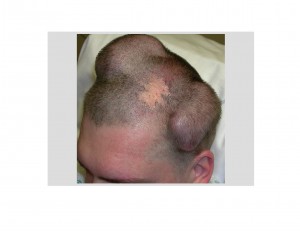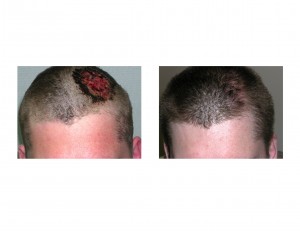Background: The scalp is exposed to a wide variety of traumatic and disease processes which can result in small to large lost segments. While smaller scalp defects can be closed by subgaleal mobilization and stretching to a moderately tight closure, defects beyond a few cms can not be so simply closed with hair-bearing scalp.
Scalp defects that can not be primarily closed requires some method to create more scalp tissue that has hair in it. One option includes rotation scalp flaps but this results in the need for long incisions beyond the defect site and the potential for more problematic scarring. While rotational scalp flaps is a well recognized reconstructive technique and offers a one-stage closure method, the additional scar concerns may be unappealing to some patients.
Another often utilized scalp reconstruction method is tissue expansion. Using differently-shaped and sized balloons implanted as as first stage procedure under normal scalp, the scalp is slowly stretched as small amounts of fluid are added every few days. The scalp responds to tissue expansion very well as the skull bone provides a rigid platform to push off of and stretch out the overlying scalp.



Scalp tissue is, by its nature, usually very tight and adherent to the convex underlying skull. While it is easily mobilized at the subgaleal level that does not mean a lot of stretching of the scalp can be done. Often only one to two cms at best can be gained of natural scalp expansion. Even if it can be stretched to close a scalp defect, tension on the scar line will result in substantial scar widening…which will not have hair and as a result becomes a very prominent scar. The use of tissue expanders can help overcome many of these scalp scar problems and is an invaluable aid in many types of scalp reconstruction.
Case Highlights:
1) Loss of hair-bearing scalp can pose a difficult problem for simple excision and closure. If able to be closed the resultant scar often widens significantly.
2) The tightness of the scalp often precludes stretching it to close over an excised area. Tissue expanders help create more scalp tissue for defect coverage.
3) Scalp reconstruction is a two-stage procedure that is spaced at a minimum 3 to 4 weeks apart or longer depending upon how much extra scalp tissue is needed. It has the advantage of no adding to the scar burden and bringing with it hair-bearing tissue.
Dr. Barry Eppley
Indianapolis, Indiana


